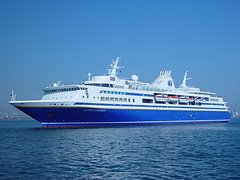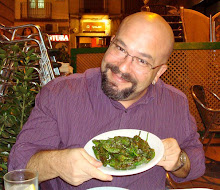We’re on the ship now, after our time in Guatemala, and I’m enjoying the calm before the grading storm. I thought I’d take advantage of the time to tell you about Nicaragua. Guatemala will come later.
After two days on the ship grading and playing Trivial Pursuit (it turns out that Tom, the Assistant Dean, and I are a killer team), I went off to the city of León to meet with Sergio Ramírez, the writer who had graciously offered to show us around the city, the setting for the novel of his that we had read in class. There were about 20 of us, including almost all of my students, the Gieses and the UVA grad students. We arrived in León at 10:30am, after an hour-long bus trip on which we read some Rubén Darío poetry, talked about modernismo, the poetic movement he spearheaded, and discussed his importance to Nicaraguan and Latin American literature. After a cup of coffee, we met with Sergio in front of the León Cathedral.
Sergio, a member of the original Sandinista junta, a former vice-president of Nicaragua, and

one of the country’s leading answering our questions about Margarita está linda la mar. We saw Darío’s tomb in the cathedral, where the poet lies under a statue of a weeping lion. Sergio was clearly a celebrity. Everyone in town seemed to know who he was, and we got to bask in the glow. After the writers, took us around the cathedral and the city, showing us the places where the novel was set, telling us about the importance of the city in Nicaragua’s cultural and political history, and tour, he and his wife took us to a restaurant in an indigenous neighborhood, where we ate fish, listened to music, drank very cold beer, and enjoyed each other’s company. The day

ended at the Rubén Darío museum, with some conversation, a brief reading, and a reception. Sergio patiently autographed all of our books before leaving for his home in Managua.
One of my students, Lindsay, later made the observation that León had not been what she had expected it to be. Knowing that the city was the scene of not only one but several of Sergio’s novels, and that it had historically served as the center of Nicaragua’s intellectual life and the incubator of its most progressive political figures, she had expected León to be

obviously monumental, lively, and attractive. She was disappointed that it was none of these things, at least not visibly so, to visitors who were there only a brief while. She wrote about the disconnect between the León she had seen and the city she had imagined while reading. There was a lesson here about the relationship between reading and traveling, about the role of literature in forging collective memory, about what a place means to insiders and how hard it can be for outsiders to perceive that place in the same way. I’m hoping that my students, in their final papers, can get at some of these issues.
Once the day with Sergio was over, most of the students headed back to the ship, while I took off for the city of Granada with David and Janna Gies. After a few hours in a car, we pulled into the Hotel Darío in Granada. The lights went out shortly afterwards. Nicaragua is rationing electricity, and Granada has no power from 8-11pm or so. We walked the streets in darkness, using my cell phone as a flashlight, looking for a restaurant that ended up seeming uninteresting. Back at the hotel, we ate lobster and drank Chilean wine before turning in, right after the power came back and the air-conditioning kicked back on.
The next day we spent the morning frenetically seeing all we could of Granada, which is known primarily for its charming central plaza. We helped a student celebrate her birthday by smacking the crap out of a piñata in her hostel with her friends, and did some shopping. Granada, it turns out, is home to some of the worst religious art I have ever seen in Latin America. The city was burnt to the ground by William Walker, the American who attempted to make himself ruler of Central America during the

19th century, and the city lost almost all of its colonial treasures in the fire. The granadinos have compensated for the loss by surrounding many of their most revered religious images with Christmas tree lights, which were unfortunately turned off during our visit. My favorite piece, however, was a statue in the church of La Merced, graced by – I kid you not – a stuffed lambie donated by one of the parish children.
Of course, my post about Nicaragua cannot compare with Zoë’s tale of eco-tourism a lo folclórico, but lest you think that I did not share in their suffering, I will have you know that my lobster was a bit over-cooked and my air-conditioning altogether too chilly.








